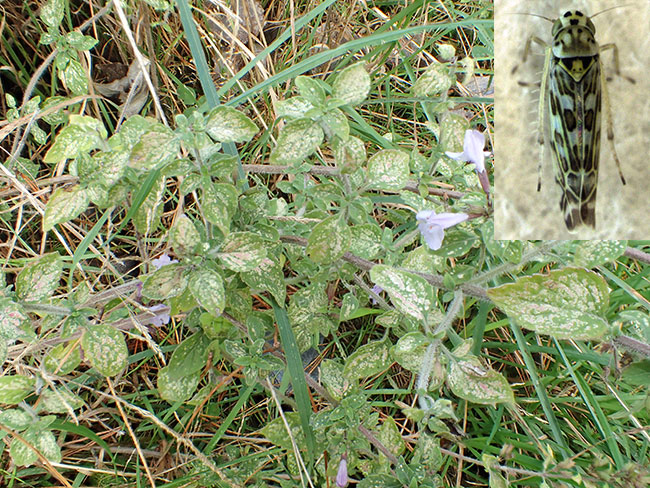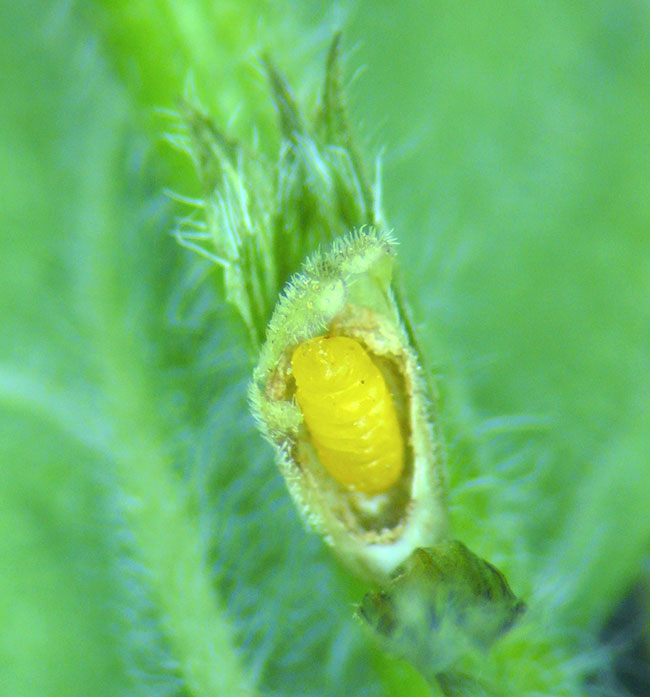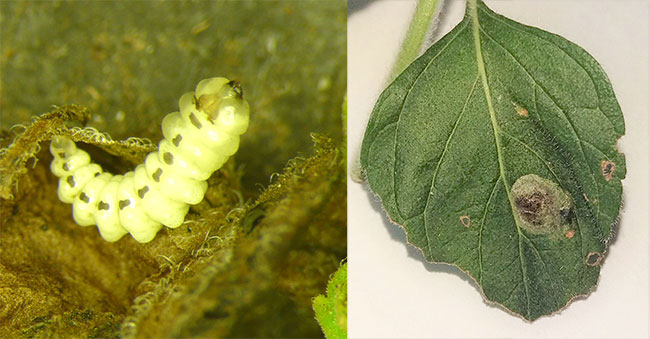Tackling Lesser Calamint with Biocontrol
A new biological control programme for lesser calamint (Calamintha nepeta) is underway in New Zealand thanks to funding granted to the Hawke’s Bay Lesser Calamint Control Group (HBLCCG) by the Sustainable Farming Fund. A 2015 study on the feasibility of using biological control to tackle lesser calamint predicted the weed would be an intermediate target in terms of the chances of success. According to Ronny Groenteman, who did the feasibility study, “a lack of close relatives to lesser calamint in New Zealand increases the likelihood of finding agents that are sufficiently host specific.” Lesser calamint is difficult to control with conventional weed management methods, so biocontrol is likely to be the best approach. The main challenge to overcome is that biocontrol has not been attempted for this weed before, and little information is available about potential biocontrol agents.”
A new biological control programme for lesser calamint (Calamintha nepeta) is underway in New Zealand thanks to funding granted to the Hawke’s Bay Lesser Calamint Control Group (HBLCCG) by the Sustainable Farming Fund. A 2015 study on the feasibility of using biological control to tackle lesser calamint predicted the weed would be an intermediate target in terms of the chances of success. According to Ronny Groenteman, who did the feasibility study, “a lack of close relatives to lesser calamint in New Zealand increases the likelihood of finding agents that are sufficiently host specific.” Lesser calamint is difficult to control with conventional weed management methods, so biocontrol is likely to be the best approach. The main challenge to overcome is that biocontrol has not been attempted for this weed before, and little information is available about potential biocontrol agents.”

Lesser calamint is a member of the mint family, Lamiaceae, and is native to Europe, North Africa (Tunisia, Algeria, Morocco), Western Asia (Iran, Turkey), and the Caucasus (Armenia, Azerbaijan, Georgia, Ciscaucasia, Dagestan). The plant is naturalised in New Zealand and the United States. First recorded in New Zealand in the 1940s, lesser calamint has spread across sheep and beef farms on the east coast of the North Island, and is currently having a serious economic impact on more than 100 farms in the Hawke’s Bay area, according to Darin Underhill of the Hawke’s Bay Regional Council. Lesser calamint is unpalatable to livestock and is strongly allelopathic, meaning that it produces toxic chemicals that suppress the growth of other species. It therefore has a negative impact on important pasture species.
Lesser calamint grows particularly well in disturbed areas with low rainfall and can tolerate drought conditions. A climate model developed by Grant Humphries (Black Bawks Data Science Ltd) predicts that over 700,000 ha of sheep and beef land could eventually be infested by the weed in New Zealand if action to curb its spread is not taken. Simon Fowler, who conducted a cost−benefit analysis, said “based on the predicted rates of spread and pasture loss, lesser calamint could cost New Zealand sheep and beef farmers up to $1.5 million annually by 2030, rapidly increasing to over $15 million by 2040, and $100 million by 2050.”
Funding for the 2-year HBLCCG project will be used to: identify the geographical origin of the lesser calamint population that has invaded New Zealand so that surveys for potential agents can be done in these areas; undertake surveys of lesser calamint throughout its current distribution range in New Zealand to identify any invertebrates or pathogens that might be using lesser calamint as a host plant, or that may potentially interfere with introduced biocontrol agents; and survey lesser calamint populations in the native range of Europe to identify and prioritise herbivorous invertebrates and plant pathogens that could be used as biocontrol agents in New Zealand. The control group is also committed to creating, and building on, community awareness and ownership of the project. So far progress has been good.

A DNA analysis comparing samples of lesser calamint from New Zealand to plant samples from the native range in Europe suggests that the New Zealand populations were introduced from Italy and/or France, and these areas should therefore be targeted for surveys for potential biocontrol agents. Focusing collections of invertebrates and pathogens from the area of origin of lesser calamint maximises the chances of finding agents that are well adapted to the plant in New Zealand, with the greatest potential for establishment and high impact.
In New Zealand, field surveys of lesser calamint are complete. According to Paul Peterson, who is leading the lesser calamint project, several herbivorous insects, none of which are specialist feeders, were found in small numbers on lesser calamint. However, two species, wheat bugs (Nysius huttoni) and sage leafhoppers (Eupteryx melissae), were found in high numbers at some sites. Wheat bugs, which are native to New Zealand and are common throughout the country, were found in very large numbers at two sites in the Hawke’s Bay area, but occurred at lower densities at other sites. Sage leafhoppers were also present at every survey site, and in some cases caused noticeable damage to lesser calamint plants, particularly the older foliage (see photo). However, Paul said, “it is important to remember that outbreaks of generalist insects are usually a response to other factors rather than a density-dependent response to the target weed species, and thus they are unlikely to contribute to effective, long-term control of the weed.” Likewise, all fungal pathogens that were collected are not specific to lesser calamint. “This research is important and valuable as it has shown us that there are currently no host-specific invertebrates or fungal pathogens feeding on lesser calamint in New Zealand that could be used for biocontrol,” said Paul.
The second aim of the lesser calamint surveys in New Zealand was to assess the potential for other organisms, such as predators and parasitoids, to interfere with the establishment and spread of new biocontrol agents. Not surprisingly, generalist predators, particularly spiders, were abundant on lesser calamint, but, more importantly, a number of parasitiods were reared from lepidopteran (moth or butterfly) larvae. This means that any species of lepidoptera released for biological control of lesser calamint would have a high risk of being parasitised and should be avoided. “For example, the parasitic wasp Meteorus pulchricornis is known to have a very wide host range and has been recorded from eight lepidopteran families in New Zealand, while another parasistic wasp, Trigonospila brevifacies, is known to parasitise at least 18 species of lepidoptera in eight families,” said Chris Winks, who helped with the surveys.
Surveys conducted by CABI-Switzerland in the native range to identify natural enemies of lesser calamint yielded some promising candidates. Specialist insects feeding on lesser calamint that were regularly encountered included a leaf-mining buprestid beetle (Trachys menthae) and a flower gall midge (Asphondylia nepetae). The gall midge is commonly parasitised by a wasp, but this is not a concern for New Zealand because insect biocontrol agents are carefully screened to ensure they are released without their own natural enemies from the native range. Another common insect found feeding on lesser calamint in southern France was an unidentified stem-mining moth. Because of the high risk of parasitism of lepidopteran biocontrol agents in New Zealand, this stem-mining moth will be of low priority for consideration as a biocontrol agent for lesser calamint in New Zealand.

Further surveys to source potential biocontrol agents for lesser calamint will focus on France and Italy and will be completed by February 2020. “At this time, we will have a clearer idea of which invertebrate and pathogen species should be selected as biocontrol candidates for lesser calamint in New Zealand. The project will then move to the next stage, focusing on host-range testing of the most promising potential agents,” said Paul.
This project is funded by the Sustainable Farming Fund, which is administered by the Ministry for Primary Industries.
CONTACT: Paul Peterson (petersonp@landcareresearch.co.nz)
